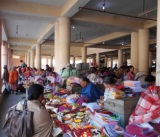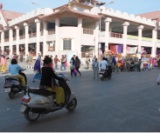Archives
Blurred Lines
These protests suffered a severe blow when on August 22, 2013, the Myanmarese army reportedly tried to set up a camp by felling trees at Hollenphai village near border pillar no. 76 even as the Ministry of Home Affairs denied any intrusion into the Indian province by Myanmar’s army. The subsequent visits of the State Governor and other high ranking officials to the affected area failed to assuage the feelings of the local people and the protest against the construction of the fence.
The international boundary between the two countries was formally demarcated following the boundary agreement on March10, 1967. Like most of the boundaries that India shares with its neighbours, the Indian Myanmar boundary is also an artificial line which is superimposed on the socio-cultural landscape of the borderland. Thus the boundary line cuts across villages and houses, dividing several tribes such as Nagas, Kukis, Mizos etc., and forcing them to reside as citizens of different countries.
| The policy makers in New Delhi have not yet given any adequate attention to the Indo-Myanmar border as can be seen from the infrastructural facilities at Zokhawatar and Moreh, the two designated points for normal trade and border trade respectively |
The Indo-Myanmar border has a unique arrangement in place called Free Movement Regime (FMR). The FMR permits the tribes residing along the border, to travel 16 kilometres across the boundary without any visa restrictions. Over the years, the Indo-Myanmar border has become the main conduit for the trafficking of arms and high quality heroin from Myanmar. Smuggling of ephedrine and trafficking of women and children from the North East region of India to Myanmar and further to South East Asia are also practices rampart along the border.
The policy makers in New Delhi have not yet given any adequate attention to the Indo-Myanmar border as can be seen from the infrastructural facilities at Zokhawatar and Moreh, the two designated points for normal trade and border trade respectively which is poor. The land customs station lacks screening and detection machines and other facilities. These infrastructural deficiencies along with a restrictive trading list and opening of Namphalong market by the Myanmar Government on the other side adversely affected normal trade at Moreh. The Government of India in 2006-07 had decided to upgrade the land customs station at Moreh to an Integrated Check Post (ICP). It was conceptualized that through this upgrade, all regulatory and security agencies within a single complex will all have modern amenities to curb smuggling and boost trade. Sadly, nothing on the ground has materialised till now.
The Government of India has been unsuccessful in garnering the cooperation of Myanmar in managing the border even though both the countries have set up a number of bilateral mechanisms at various levels to discuss issues related to border security and management as well. India should endeavour for meaningful dialogue with Myanmar and solicit its cooperation in resolving all outstanding issues for better mutual relationship.
Besides this, various social organisations demanded for an early solution to the border dispute. Recently, a people’s dialogue programme on the issue of border fencing was held at Manipur Press Club. Altogether 12 persons representing different political parties and social organisation spoke at the people’s dialogue programme. The programme was moderated by Professor H. Jayantakumar and senior journalist AK. Sanaton. A majority of the speakers at the gathering maintained that the ongoing border fencing work should be put on hold until the unclear border lines are demarcated properly.
| The Indo-Myanmar border has a unique arrangement in place called Free Movement Regime (FMR). The FMR permits the tribe residing along the border, to travel 16 kilometres across the boundary without any visa restrictions. |
In order to exert pressure on the Centre to resolve the Indo-Myanmar border dispute that has reportedly led to a loss of a large chunk of Manipur’s land on account of the border fencing work along the yet to be demarcated border areas, a delegation of representatives of all political parties of the State met the Prime Minister and Union Home Minister in New Delhi on December 4th, 2013. The delegation was led by the Chief Minister and the Deputy Chief Minister of the State.
The Prime Minister Dr. Manmohan Singh assured the delegates led by the State Chief Minister O. Ibobi that not an inch of Indian territory on the Manipur border would be conceded to the neighbouring country. The Prime Minister gave a patient hearing to the presentations of the delegation and informed that he would take up the matter with the Union Home Minister of India and asked the delegation to meet the Minister too. The Prime Minister also stated that he would instruct the authority concerned to stop the ongoing construction of the border fencing.
In the meeting with Union Home Minister Sushil Kumar Shinde in his office chamber at North Block, the Union Home Minister noted the gravity of the situation which immediately led to the convening of a meeting of all departments concerned including Assam Rifles, Google, Border Road Organisation, Surveyor General of India with the all political party delegation of the State.
 The delegation had also submitted a memorandum which stated that Manipur in the historical past was an independent princely kingdom of South East Asia with its own distinct socio-cultural and historical entity for more than two millennia. The ancient boundaries of the kingdom of Manipur extended up to the southern bank of the Brahmaputra in the North, Lushai Hills (now Mizoram) in the south, up to the confluence of the Irrawaddy - Chindwin rivers of the then Burma in the east, and up to the Cachar valley districts of Assam in the west. (Report on the Eastern Frontier of British India by Capt. RB Premberton, 1835).
The delegation had also submitted a memorandum which stated that Manipur in the historical past was an independent princely kingdom of South East Asia with its own distinct socio-cultural and historical entity for more than two millennia. The ancient boundaries of the kingdom of Manipur extended up to the southern bank of the Brahmaputra in the North, Lushai Hills (now Mizoram) in the south, up to the confluence of the Irrawaddy - Chindwin rivers of the then Burma in the east, and up to the Cachar valley districts of Assam in the west. (Report on the Eastern Frontier of British India by Capt. RB Premberton, 1835).
It further stated that during the British regime, the boundaries of Manipur continued to shrink. After the Treaty of peace signed at Yandaboo on February 24, 1826 and Agreements regarding the Kabow valley at Sunymachil Ghat on January 9, 1834, the eastern boundary of Manipur receded to the present day boundary. In this process, many of the villagers belonging to the same ethnic communities were abruptly separated from each other (i.e. 12 villages of Tangkhuls in Somra Tract and another 5 villages of Kangpat fell into Burmese territory). Till today, the result of these events continues to be a sensitive issue for the people of Manipur.
The then Maharaja of Manipur signed the Merger Agreement on September 21, 1949 with India, through which Manipur became a part of the Dominion of India on 15th October, 1949. Protection  and control of the boundaries of Manipur thereafter were vested with the Government of India. The Indo - Burma boundary was delimited through a bi-lateral agreement signed between India and Burma on March 10, 1967 in Rangoon. In terms of the said agreement, the International Boundary Line is to be demarcated based on the Traditional Boundary Line. However, after the agreement, the formal boundary delimitation and demarcation were done on maps in between the two countries. Both the countries further rectified the agreement and the Instrument of Ratification was signed and exchanged in New Delhi on May 30, 1967, it further stated. The memorandum pointed out that the actual physical boundary delimination on the ground was conducted w.e.f. April 5, 1975 without any responsible representatives from the State of Manipur. The identification of the traditional boundary line on the grounds was decided by the officials of the Burmese Government as none of the Indian representatives were familiar with the ground position. Since, then tension along the Indo - Burma line has continued to simmer. As per documents available, Border Pillars (BPs) were to be erected along the Indo - Burma International Boundary in the Manipur sector. Taking into consideration the field position found during the site visit and the facts stated above, members of all the political parties of Manipur unanimously resolved to submit a seven point memorandum to the Government of India for urgent necessary action.
and control of the boundaries of Manipur thereafter were vested with the Government of India. The Indo - Burma boundary was delimited through a bi-lateral agreement signed between India and Burma on March 10, 1967 in Rangoon. In terms of the said agreement, the International Boundary Line is to be demarcated based on the Traditional Boundary Line. However, after the agreement, the formal boundary delimitation and demarcation were done on maps in between the two countries. Both the countries further rectified the agreement and the Instrument of Ratification was signed and exchanged in New Delhi on May 30, 1967, it further stated. The memorandum pointed out that the actual physical boundary delimination on the ground was conducted w.e.f. April 5, 1975 without any responsible representatives from the State of Manipur. The identification of the traditional boundary line on the grounds was decided by the officials of the Burmese Government as none of the Indian representatives were familiar with the ground position. Since, then tension along the Indo - Burma line has continued to simmer. As per documents available, Border Pillars (BPs) were to be erected along the Indo - Burma International Boundary in the Manipur sector. Taking into consideration the field position found during the site visit and the facts stated above, members of all the political parties of Manipur unanimously resolved to submit a seven point memorandum to the Government of India for urgent necessary action.
In a later development, the Union Home Minister, Sushil Kumar Shinde has directed all heads of the agencies associated with the construction of the border fence in Manipur to visit the border areas to make on the spot assessment on December 7 and 8. So, as directed by the Union Home Minister, a joint team comprising officials from Ministry of Home Affairs, BRO officials, Surveyor General of India, representatives of the Government of Manipur and political parties visited Moreh on December 7 to make an assessment of the border fencing. The joint inspection team which was led by the Deputy Chief Minister of Manipur, Gaikhangam, who is also in charge of Home, also included Joint Secretary (North East in-charge) of Ministry of Home Sambhu Singh; Joint Secretary (Border Management), SK. Mishra; Director of Surveyor Genreal of India (SOI) Srinivas KK Das Sarkar of SOI, Chief Engineers of BRO Sewak, Project VK Agarwal. Talking to the media fraternity after inspecting Border Pillar No. 23 at Holangphai Village, BP 77, 21 near Tamil Sangam, BP 79 Muslim Basti, BP 80 at Govajang Village, Shambhu Singh said that the Ministry will call on Myanmar to resolve the current Indo - Myanmar border row, at Moreh in Chandel district through a diplomatic level. The Union Government will invite Myanmar for a bilateral meeting at the end of this month or first week of next year in this regard, he disclosed.
Meanwhile, the Deputy Chief Minister appealed to the general public, security forces and other agencies to be more responsive in informing authorities concerned in the event of any incident that affect the interest of the nation. Further, he urged law enforcing agencies including the Assam Rifles, State forces etc. to be more alert. What lies beyond all these developments on the border issue is yet to revealed even as the desire of the general public is to bring about an amicable solution as soon as possible.

